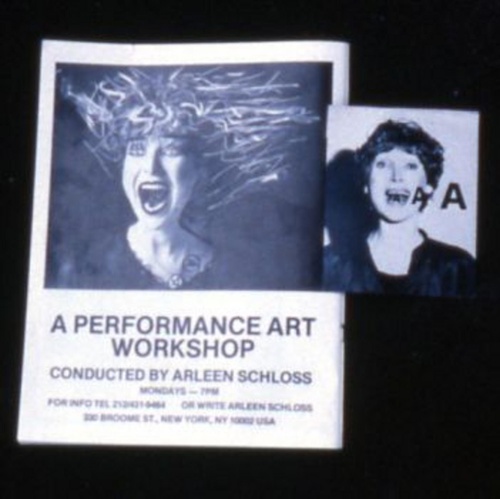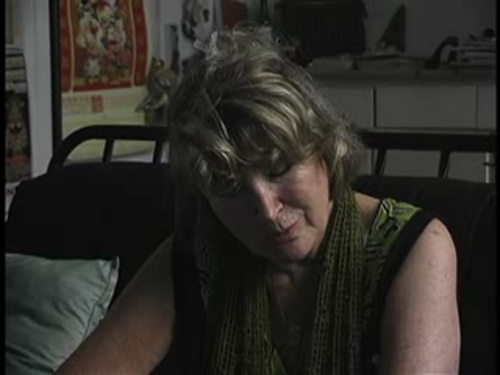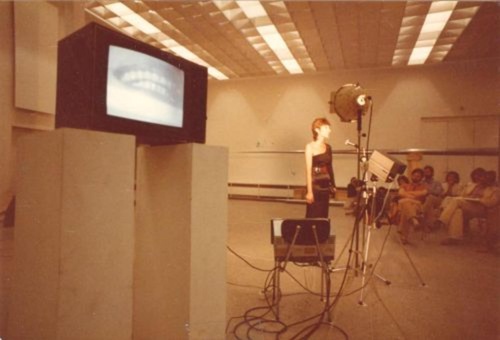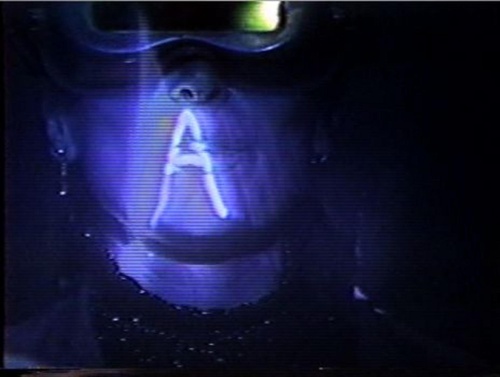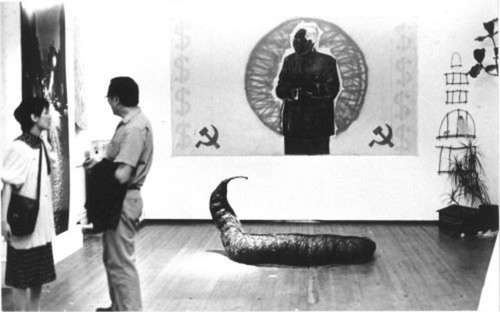Bowery Artist Tribute: Arleen Schloss
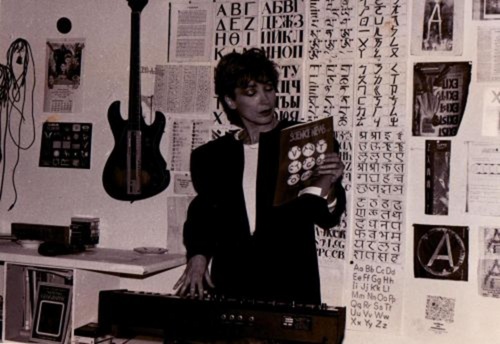
Arleen Schloss at A’s, 1986
BOWERY ARTIST TRIBUTE
ARLEEN SCHLOSS, ARTIST
INTERVIEWEE: Arleen Schloss
TIME ON THE BOWERY: 1970-present
INTERVIEWER: Matthew Israel
LOCATION: Schloss’ Studio, Broome Street and Bowery
This transcript has been excerpted and condensed from the Bowery Artist Tribute interview that took place on July 24, 2008. The full video recordings of these interviews are currently being digitized from the original tapes and are available from the New Museum Archives by request.
Arleen Schloss (b. 1943) has worked interchangeably in a variety of mediums, including performance art, sound poetry, music, painting, film, and video. Presented in spaces as varied as the Kitchen, MoMA, the Ars Electronica festival, and her own home, Schloss’s performances possess a spirit described by Linda Burnham as “a contagious sense of wonder.” 1 These presentations, which could involve Schloss’s cyclical recitation of the alphabet, live painting, closed-circuit video, and music all at once, combine the anti-art whimsy of Fluxus, Cageian indeterminacy, and a site-specific empathy that made every act unique. Trained as a painter, Schloss began hosting performance art workshops in her loft during the 1970s. These workshops demanded a performance space, and in 1979, A’s was born. Each Wednesday night, Schloss opened her loft to the public, offering a diverse program of dance, music, and performance, including such artists as Jean-Michel Basquiat, Phoebe Legere, Glenn Branca, Berhard Heidsieck, Eric Bogosian, Alan Vega, and Y Pants. On weekends, the space doubled as A Gallery, offering space for visual artists. Especially notable were two group shows in 1985: “The Asia Show,” which included works by Nina Kuo, Bing Lee, Ai Weiwei, Tehching Hsieh, and Shirin Neshat; and “The Friends Show,” which involved over one hundred artists, including Willoughby Sharp, Kim Jones, and Schloss’s parents.
Bowery Artist Tribute interview with Arleen Schloss, July 24, 2008, Clips
ARLEEN SCHLOSS: Even though it was the late ’60s, we kind of knew that SoHo was going to become fashionable and turn into something, and we wanted to be off to the side. We were all being thrown out of where we were living on East Broadway because the building had been bought. There was no one in this building, and we moved in as a group of artists. One of the people in the group was a dancer who danced with Merce Cunningham. One artist had a place called the Rivington School, here in Manhattan. We were all experimental artists, testing and trying different things.
When I first arrived here I was painting with my feet because there was no wall space. That turned into performance art workshops. In 1970 I did a performance called Feet in an experimental space on Prince Street. I did a large workshop with a number of people to take off their shoes and socks and walk in mounds of hot pink Play-Doh. It was like you were hanging out on the moon.
I was working in the neighborhood with children that didn’t speak English. I was experimenting then too, trying to find creative ways to teach language. This was in the early ’70s. I became a resource for City as School, which was here in Lower Manhattan. I worked with high school students that couldn’t work in regular classrooms. I would take them out to Tompkins Square Park, we would do art around the park and they would paint as part of the whole outdoor institution. I was never thinking about doing things at galleries.
A’s formed because I was giving performance art workshops and working with friends and other people to help develop works using their voice and sound and experimenting with creative ideas. The workshops increasingly became more popular and grew quite large so I opened it as a space for creation of works by different artists. As soon as people heard about it they rushed here because the Mudd Club was on the expensive side. The public were artists, basically from the ’hood, and also from Europe. Everyone was open and loving what was going on because everyone was experimenting.
It was a chance to try your ideas. The first band that played here was Grey, Jean-Michel Basquiat’s band. He came in to play in his pajamas. Everything was on the edge and people were just doing whatever they were doing. Mania D, a German all-women band played the same night. The whole point about A’s was loving what you do. And if you’re serious, and you love what you do, then you do it. And I’m open. 2
Full transcripts are available from the New Museum Archives by request.
-
Linda Burnham, “Arleen Schloss,” in High Performance, issue 19, vol. 5, no. 3, 1982.
-
New Museum. “Bowery Artist Tribute Vol. 2,” New Museum, Volume 2, 2008, 16-17.
